Related Research Articles

Soyuz is a series of spacecraft which has been in service since the 1960s, having made more than 140 flights. It was designed for the Soviet space program by the Korolev Design Bureau. The Soyuz succeeded the Voskhod spacecraft and was originally built as part of the Soviet crewed lunar programs. It is launched on a Soyuz rocket from the Baikonur Cosmodrome in Kazakhstan. Between the 2011 retirement of the Space Shuttle and the 2020 demo flight of SpaceX Crew Dragon, the Soyuz served as the only means to ferry crew to or from the International Space Station, for which it remains heavily used. Although China did launch crewed Shenzhou flights during this time, none of them docked with the ISS.

The Progress is a Russian expendable cargo spacecraft. Its purpose is to deliver the supplies needed to sustain a human presence in orbit. While it does not carry a crew, it can be boarded by astronauts when docked to a space station, hence it is classified as crewed by its manufacturer. Progress is derived from the crewed Soyuz spacecraft and launches on the same launch vehicle, a Soyuz rocket.
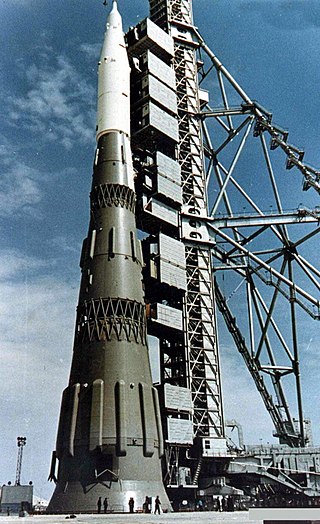
The N1/L3 was a super heavy-lift launch vehicle intended to deliver payloads beyond low Earth orbit. The N1 was the Soviet counterpart to the US Saturn V and was intended to enable crewed travel to the Moon and beyond, with studies beginning as early as 1959. Its first stage, Block A, was the most powerful rocket stage ever flown for over 50 years, generating 45.4 MN of thrust. However, each of the four attempts to launch an N1 failed in flight, with the second attempt resulting in the vehicle crashing back onto its launch pad shortly after liftoff. Adverse characteristics of the large cluster of thirty engines and its complex fuel and oxidizer feeder systems were not revealed earlier in development because static test firings had not been conducted.
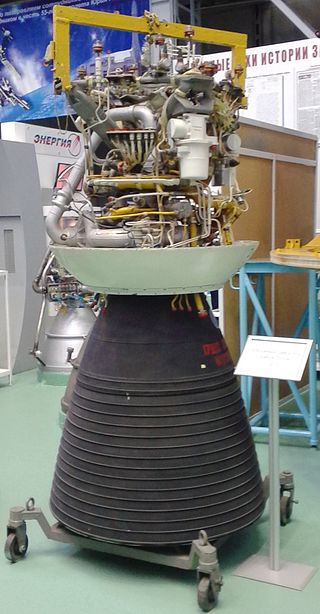
The RD-58 is a rocket engine, developed in the 1960s by OKB-1, now RKK Energia. The project was managed by Mikhail Melnikov, and it was based on the previous S1.5400 which was the first staged combustion engine in the world. The engine was initially created to power the Block D stage of the Soviet Union's abortive N-1 rocket. Derivatives of this stage are now used as upper stages on some Proton and Zenit rockets. An alternative version of the RD-58 chamber, featuring a shorter nozzle, was used as the N-1's roll-control engine.

The AJ10 is a hypergolic rocket engine manufactured by Aerojet Rocketdyne. It has been used to propel the upper stages of several launch vehicles, including the Delta II and Titan III. Variants were and are used as the service propulsion engine for the Apollo command and service module, in the Space Shuttle Orbital Maneuvering System, and on the European Service Module – part of NASA's Orion spacecraft.

Progress-M1 (Russian: Прогресс-М1, GRAU indices 11F615A55 and 11F615A70), also known as Progress 7K-TGM1, is a Russian spacecraft which is used to resupply space stations. It is a variant of the Progress spacecraft, derived from the Progress-M, but modified to carry more UDMH and N2O4 propellant for refuelling the International Space Station instead of other cargoes such as water. A Progress M1 11F615A55 spacecraft could carry up to 1,700 kilograms (3,700 lb) of propellant in eight mid-section refuelling tanks, compared to the 850 kilograms (1,870 lb) that a Progress-M of the same generation could carry. This propellant can be transferred to the Space Station's own propulsion system through fluid connectors in the docking ring, or it can alternatively be used by the Progress' thrusters to boost the station altitude or to change its orientation, or attitude, in space. In addition to propellant, the spacecraft can also carry up to 1,800 kilograms (4,000 lb) (6 cubic meters volume) of supplies in its forward pressurized cargo module (including a maximum of 40 kilograms (88 lb) of compressed air), but the combination of pressurized cargo and refuelling propellant cannot exceed 2,500 kilograms (5,500 lb) or the maximum capability of the launch vehicle. The tare weight of Progress-M1 is 5,050 kilograms (11,130 lb). Its KTDU-80 engine has a thrust of 2,950 newtons (660 lbf) and uses up to 892 kilograms (1,967 lb) of propellant carried in four integrated spherical tanks for maneuvers such as docking and deorbiting the craft; 185 kilograms (408 lb) to 250 kilograms (550 lb) is typically left unused and hence available for the space station.
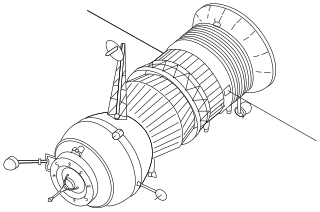
Progress 7K-TG, was a Soviet uncrewed spacecraft used to resupply space stations in low Earth orbit. Forty three flew, delivering cargo to Salyut 6, Salyut 7, and Mir. It was the first version of the Progress spacecraft to fly, and spawned later derivatives including the Progress-M which replaced it, and the later Progress-M1.

Progress 2 was an unmanned Progress cargo spacecraft launched by the Soviet Union in 1978 to resupply the Salyut 6 space station. It used the Progress 7K-TG configuration, and was the second Progress mission to Salyut 6. It carried supplies for the EO-2 crew aboard Salyut 6, as well as equipment for conducting scientific research, and fuel for adjusting the station's orbit and performing manoeuvres.
The S5.98M, also known as the 14D30, is a Russian rocket engine, currently powering the Briz upper stages. It was designed by KB KhIMMASH, the famous Isaev designed bureau, and it burns UDMH and N2O4 in a gas-generator cycle.
KVD-1 was an upper stage LOX/LH2 cryogenic engine developed by the Isayev Design Bureau (now KB KhIMMASH) of Russia in the early 1960s. It is a modified version of the RD-56, developed for a never-completed cryogenic upper stage of the N-1 super-heavy lift rocket, with the goal of enabling crewed lunar missions by the USSR. The KVD-1 produces a thrust of 7.5 tonnes.
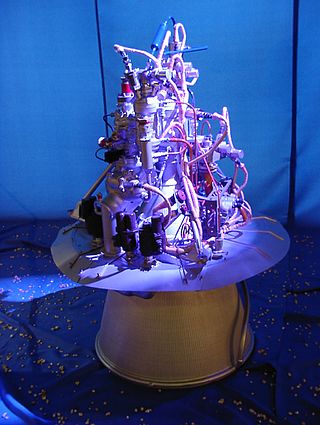
The RD-0109 is a rocket engine burning liquid oxygen and kerosene in a gas generator combustion cycle. It has single nozzle and is an evolution of the RD-0105. It was the engine used on the Vostok Block-E that launched Yuri Gagarin to orbit.
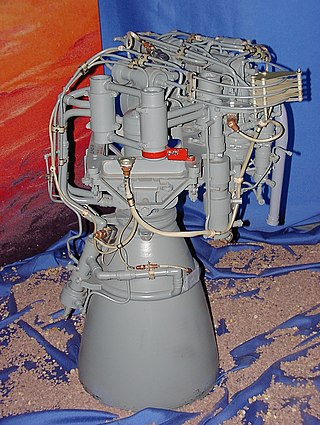
The S5.92 is a Russian rocket engine, currently used on the Fregat upper stage.

The RD-0210 (GRAU Index: 8D411K) is also known as the RD-465. It and its twin, the RD-0211, are rocket engines burning N2O4 and UDMH in an oxidizer rich staged combustion cycle. They have single nozzle, possess TVC and are the latest evolution in the RD-0203/4 lineage. They are the engines used on the Proton second stage. The RD-0213 is a fixed nozzle variation that is used on the RD-0212 module of the Proton third stage.
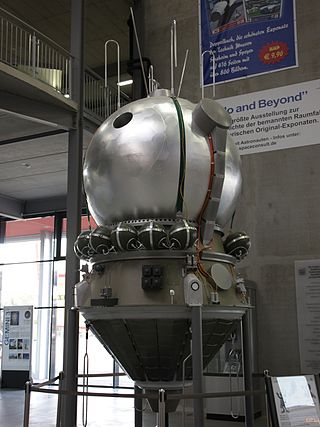
The S5.4, was a Russian liquid rocket engine burning TG-02 and AK20F in the gas generator cycle. It was originally used as the braking (deorbit) engine of the Vostok, Voskhod, and Zenit spacecraft, which later switched to solid engines.

The KTDU-80 (Russian: Корректирующе-Тормозная Двигательная Установка, КТДУ) is the latest of a family of integrated propulsion system that KB KhIMMASH has implemented for the Soyuz since the Soyuz-T. It integrates main propulsion, RCS and attitude control in a single system pressure fed from a common dual string redundant pressurized propellant system. The common propellant is UDMH and N2O4 and the main propulsion unit, is the S5.80 main engine. It generates 2.95 kN (660 lbf) of thrust with a chamber pressure of 880 kPa (128 psi) and a nozzle expansion of 153.8 that enables it to achieve a specific impulse of 302 s (2.96 km/s). It is rated for 30 starts with a total firing time of 890 seconds. The integrated system without the pressurization or tanks weighs 310 kg (680 lb); it is 1.2 m (47 in) long with a diameter of 2.1 m (83 in).
The S5.80 is a liquid pressure-fed rocket engine burning N2O4/UDMH with an O/F of 1.85. It is used for crew-rated spacecraft propulsion applications. It is currently used in the Soyuz-TMA-M spacecraft propulsion module KTDU-80, and its sibling, the S5.79 rocket engine, is still used as the main propulsion of the Zvezda ISS module. The S5.80 generates 2.95 kN (660 lbf) of thrust with a chamber pressure of 0.88 MPa (128 psi) and a nozzle expansion of 153.8 that enables it to achieve a specific impulse of 302 s (2.96 km/s). It is rated for 30 starts with a total firing time of 890 seconds. The engine, without the pressurization system or propellant tanks, weighs 310 kg (680 lb) and is an integrated unit that is 1.2 m (47 in) long with a diameter of 2.1 m (83 in).
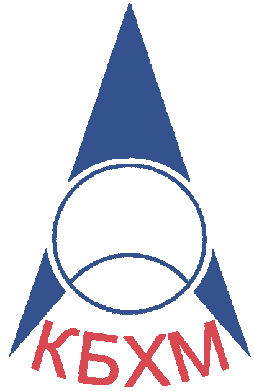
The A.M. Isayev Chemical Engineering Design Bureau, also known as KB KhimMash or just KBKhM, is a Russian rocket engine design and manufacturing company. It is located in the city of Korolyov. It started as the OKB-2 division of the NII-88 research institute, where A.Isaev directed the development of liquid rocket engines for ballistic missile submarines.

FSUE Research and Development Institute of Mechanical Engineering, also known as NIIMash, is a Russian rocket engine design and manufacturing company specialized in small thrusters. It is located in the city of Nizhnyaya Salda, Sverdlovsk Oblast. It started as the B-175 factory of the NII-1 research institute, where Mikhail G. Mironov directed the development of liquid rocket engines research and testing.
The 11D428A-16 (manufacturer's name RDMT-135M) is a liquid pressure-fed rocket engine burning N2O4/UDMH with an O/F of 1.85. It is used for crew-rated spacecraft propulsion applications. It is currently used in the KTDU-80 spacecraft propulsion module. The previous version, the 11D428A (manufacturer's name RDMT-135) is still used as the reaction control system thrusters of the Zvezda ISS module. The 11D428A-16 generates 129.16 N (29.04 lbf) of thrust with a chamber pressure of 0.88 MPa (128 psi) and achieves a specific impulse of 291 s (2.85 km/s). It is rated for 500,000 starts with a certified ignition time of 0.03 seconds to 2000 seconds. Each unit weights 1.5 kg (3.3 lb).
The S5.142 (AKA DST-25) is a liquid pressure-fed rocket engine burning N2O4/UDMH with an O/F of 1.85. It is used for crew-rated spacecraft propulsion applications. It was used in KTDU-80 propulsion module from the Soyuz-TM to the Soyuz-TMA-M, as the low thrust thruster (DPO-M). As of the Soyuz MS, KTDU-80 does not use DPO-M anymore.
References
- ↑ Brügge, Norbert. "Spacecraft-propulsion blocks (KDU) from Isayev's design bureau (now Khimmash)". B14643.de. Archived from the original on 2015-06-02. Retrieved 2015-06-02.
- ↑ "Soyuz". Rocket and Space Technology. Retrieved 2015-07-08.
- 1 2 3 4 "KTDU-35". Encyclopedia Astronautica. Archived from the original on June 25, 2002. Retrieved 2015-07-25.
- 1 2 3 4 5 "Основные двигатели разработки КБХМ" [The main engines produced by KbKhA] (in Russian). Retrieved 2015-07-25.
- ↑ Pillet, Nicolas. "Le système de propulsion du vaisseau Soyouz" [The propulsion system of the Soyuz spacecraft] (in French). Kosmonavtika.com. Retrieved 2015-07-14.
- ↑ McDowell, Jonathan. "5.2: Russian engines". Jonathan Space Report. Retrieved 2015-07-25.
- ↑ Chertok, Boris (May 2009). "Chapter 18 – Birth of the Soyuzes". Rockets and People Vol. 3 – Hot Days of the Cold War (PDF). Vol. 3 (NASA SP-2006-4110). NASA. p. 562. ISBN 978-0-16-081733-5 . Retrieved 2015-07-15.
- ↑ "KTDU-66". Encyclopedia Astronautica. Archived from the original on August 25, 2002. Retrieved 2015-07-25.
